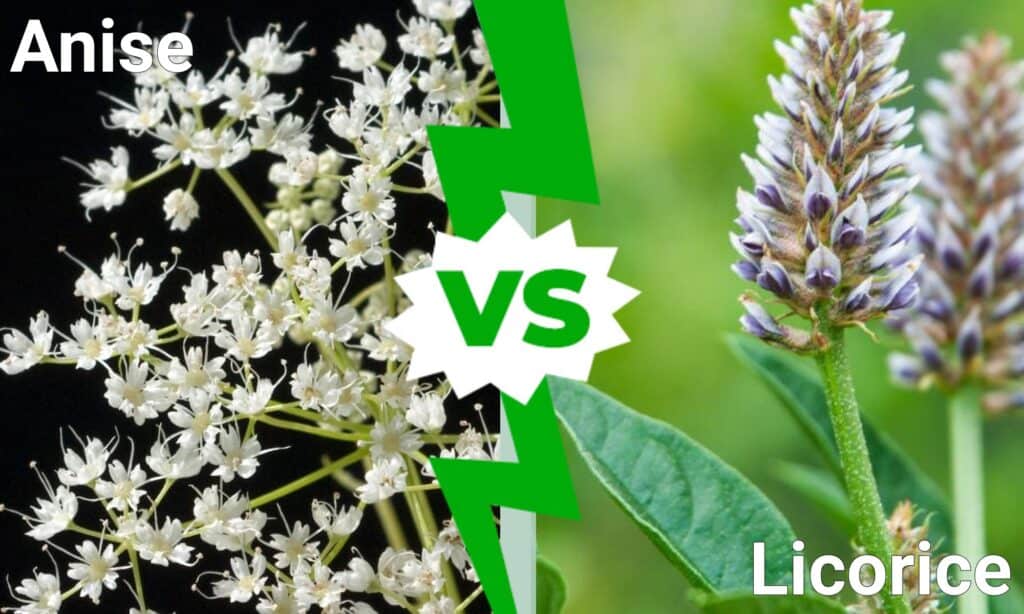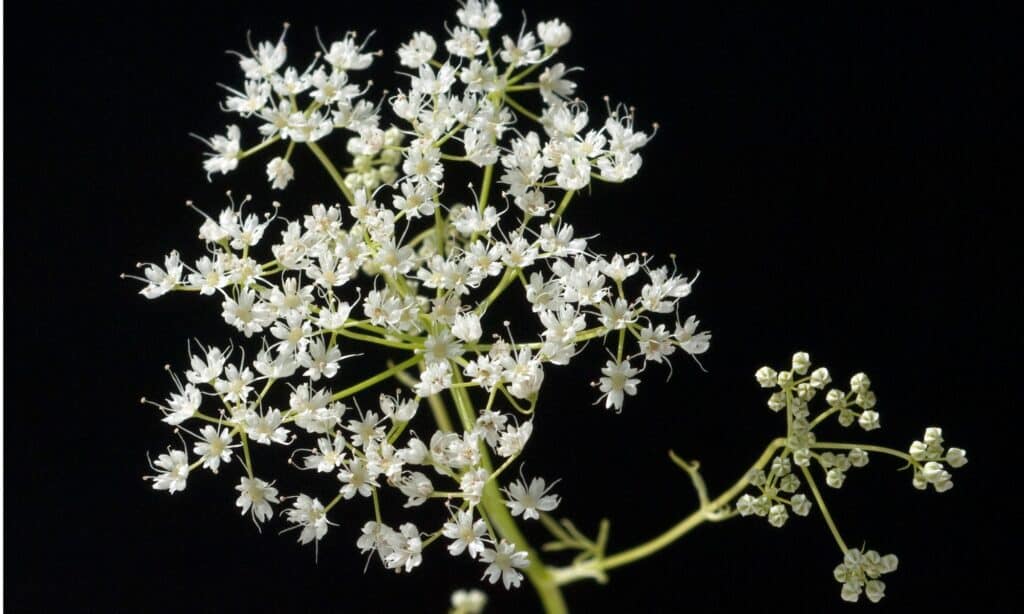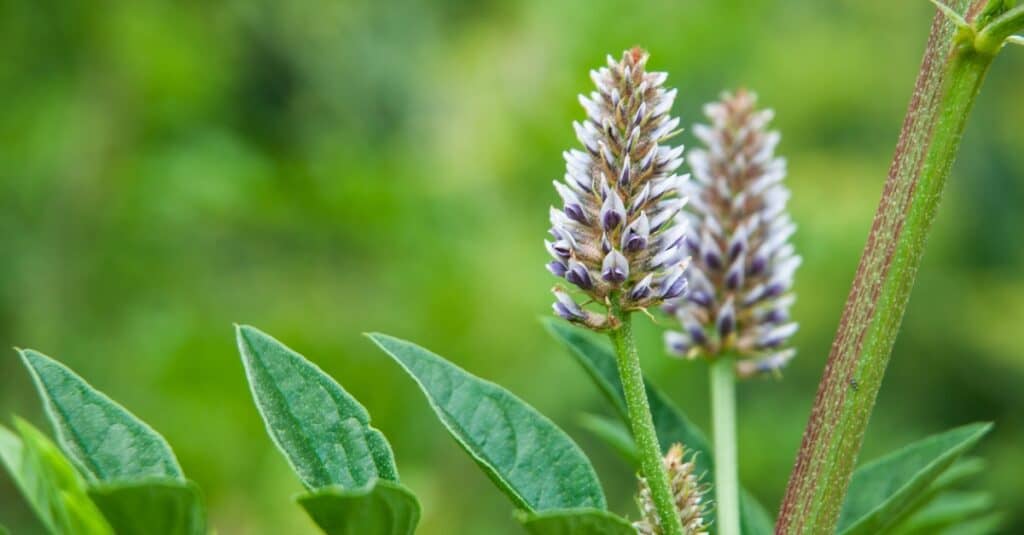If you’re familiar with the sweet, highly aromatic herbs like anise, and licorice, you may be wondering what the differences are between these two plants. So, if you just compare their aromas and their use in culinary applications, you may think anise and licorice would be difficult to distinguish from each other. However, when comparing the physical characteristics and growing habits of anise vs. licorice, these plants are actually easy to tell apart.
In this guide, we’ll discuss how to distinguish these highly valued herbs from each other. We’ll also dive into their botanical classifications, ancient and present-day uses, and ideal growing conditions. So, without further ado, let’s dive in!
Anise vs. Licorice: A Quick Look

| Anise | Licorice | |
|---|---|---|
| Plant Classification | Pimpinella anisum | Glycyrrhiza glabra |
| Plant Characteristics | Flowering, annual herb in the parsley family. Grows up to about 3 feet long. At base of plant, leaves are simple, long stalked, and shallowly lobed. Higher up on the plant, leaves are pinnately compound, have shorter stalks, and are feathered. Produces tiny flowers in disc-shaped clusters called umbels. | Flowering, perennial herb in the bean family. Typically grows between 3-7 feet in height. Produces pinnately compound, velvety grey-green oblong leaves that grow in an alternating pattern. Produces upright stalks of tiny pale blue-violet flowers. |
| Native Range and Ideal Growing Conditions | Native to Eurasia. Prefers to grow in full sun of at least 6 or more hours of direct sunlight. Thrives in well-draining, organically rich soil with a pH of 6.0-6.7. Plant is somewhat drought-tolerant but does not tolerate soggy soil. Thrives in USDA growing Zones 4-10. | A widespread perennial herb native to Europe, West Asia, North Africa, and most of North America. Grows best in fertile soil with good moisture retention, but well-draining. Fertile, loamy, neutral to slightly alkaline soil is ideal. Prefers full sun but can tolerate partial shade. Thrives in USDA growing Zones 6-11. |
| Culinary and Fragrance Uses | Seeds are used as a wonderfully aromatic, sweet spice used for flavoring savory and sweet dishes and drinks. Also used in perfumes, bathing products, and scenting candles. | Root is intensely sweet and used in the production of candies, desserts, and other sweet treats and drinks. Used in fragrances, though not as commonly as anise. |
| Potential Medicinal Uses | Studies demonstrate components of anise have antimicrobial, antioxidant, and gastric protective effects. Historically, anise has been widely used in the Middle East for the above-mentioned effects. | Traditionally used for thousands of years in Western and Eastern medicine for gastric protective, anti-inflammatory, expectorant, and respiratory protecting effects. |
Key Differences Between Anise And Licorice
The major differences between anise and licorice include height, ideal growing conditions, potential uses, plant classification, and physical characteristics.
Keep reading below for an in-depth explanation of the differences that exist between anise and licorice.
Anise vs. Licorice: Plant Classification

Anise belongs to the parsley family.
©iStock.com/emer1940
While anise and licorice have similar aromatic properties and similar culinary and fragrance uses, they belong to totally distinct botanical families. Anise’s genus and species is Pimpinella anisum, and it belongs to the Apiaceae, or parsley family. Comparatively, licorice’s botanical name is Glycyrrhiza glabra and it belongs to the Fabaceae, or legume family.
Anise vs. Licorice: Plant Characteristics
Regarding the physical characteristics of anise and licorice, these two plants have notably distinct features and are easy to distinguish from one another.
Anise is an annual flowering herb that grows to about 3 feet in height at maturity. It produces both simple and compound leaves. At the base of an anise plant, the leaves are simple, lobed, and grow from short stalks (petioles) from the plant’s main stem. Further up the plant, anise leaves become pinnately compound and feathered. Pinnately compound leaves are comprised of a row of leaflets that grow from an extended petiole called a rachis. The plant forms tiny white flowers in disc-shaped clusters called umbels. Umbels are a common feature of many plants in the Apiaceae family. After the plant has flowered, it produces highly aromatic, small, pale brown seeds from the umbels.
Compared to anise, licorice can grow much taller with a maximum height of 6-7 feet. This perennial flowering herb produces pinnately compound, oblong leaves that grow opposite each other along the rachis. It produces small 4-inch long bunches of tiny pale blue-violet flowers along upright stalks. The root of licorice is highly valued for its culinary, medicinal, and fragrance applications. The fresh root of licorice is woody, pliable, and dark brown. It is highly fragrant and has a similar scent to anise seeds.
Anise vs. Licorice: Native Range and Ideal Growing Conditions
The native range of anise extends from the Mediterranean through Central Asia. As a widely popular herb and spice, it is now grown in suitable conditions around the world. While anise has a fairly limited native range, licorice’s native range includes Europe, North Africa, West Asia, and most of North America. Like anise, this highly valued herb is now grown in favorable conditions all around the world.
Anise’s Ideal Growing Conditions
As a sun-loving plant, anise prefers to grow in at least six hours or more of direct sunlight. It will become leggy and less productive if grown in partial shade.
This plant thrives in well-draining, organically-rich soil with a slightly acidic pH of 6.0-6.7. It can tolerate poorer soil types and drought conditions, but it does not tolerate soggy soil where its roots will become water-logged. Anise grows best in USDA hardiness zones 4-10. If you live in zones 6 or less, you may want to grow anise in a pot and bring it inside once temperatures drop below 60 degrees. Just make sure to place the plant where it will still receive its sunlight requirements.
Licorice’s Ideal Growing Conditions
Regarding its ideal growing conditions, licorice prefers to grow in deep, loamy, fertile, slightly alkaline soil that is both well-draining and also has good moisture retention. Its deep root system requires particularly loose and deep soil. It will not thrive in compacted or clay soil types. While licorice can tolerate high winds, it can not adapt to coastal winds with high salt concentrations. This sweet plant thrives in USDA hardiness Zones 6a-11a.
To harvest licorice root, the plant needs to be at least two years old, and it should be harvested in the Fall. You’ll know the plant is ready to harvest when the flowers have finished blooming, and the growing season is complete. If you want to continue growing licorice after harvesting the entire plant, you can collect the seeds during harvest to plant in the following season. The root system can be rather large, so take care to dig a wide circle around and under the plant to avoid cutting into the roots.
Anise vs. Licorice: Culinary and Fragrance Uses

Licorice is used in making fragrances.
©iStock.com/Carmen Hauser
Similar to anise, people have used licorice for thousands of years as a sweet flavoring agent in candies, desserts, and sweet drinks. However, licorice is much more acutely sweet than anise. In fact, the active compound in licorice root, glycyrrhizic acid, is 50 to 170 times sweeter than sucrose (sugar). Licorice is also used in fragrances and bathing products, although it is not as popular for use in fragrances as the more complexly aromatic anise.
As a highly aromatic herb, anise has been used for thousands of years to flavor dishes and drinks, and to scent candles and bathing products. It has also been processed into essential oils for its soothing scent.
The complex aroma and flavor of anise make it highly versatile in its culinary applications. People use anise spice in both savory and sweet dishes such as sausages, savory soups, sweet drinks, and desserts. People also use the leaves in salads and as flavoring in beverages. In Italy, bakers commonly use anise seeds to make anise biscottis while restaurants prepare sausages with ground anise seeds. In North Africa, anise is often used in cookies and savory meals, such as lamb and chicken dishes.
Anise vs. Licorice: Potential Medicinal Uses
As a medicinal herb, people across the Mediterranean and Central Asia have traditionally used anise for its antioxidant, gastric protective, anti-inflammatory, and anti-microbial effects. Indeed, research suggests chemical components in anise do have the above-mentioned effects in certain preparations.
One study compared the pharmacological effects of various parts of the anise plant in a variety of preparations such as hot-water extract, essential oil, and alcohol extract. So, depending on what part of the plant and what preparations researchers used, they could study the biological effects of anise’s various active compounds. For instance, researchers found that anise tea contained antioxidants beneficial to the human immune system.
In terms of medicinal use, the licorice plant has a long history in both Eastern and Western traditional medicine. Historically, people have used licorice root for a plethora of effects such as anti-inflammatory, anti-microbial, anti-allergic, gastric protective, and respiratory protective.
Presently, extensive modern research has been published on the beneficial pharmacological effects of various compounds in licorice, including glycyrrhizic acid. Current research supports the ancient use of licorice for the above-mentioned effects in certain applications and through certain preparations. Use of licorice, especially long-term, can also cause significant adverse health effects and like any medicine, should be used only under the active guidance of a qualified medical professional.
Please note: A-Z Animals does not recommend plants or herbs for medicinal or health use. We present the following information for academic and historical purposes only.
Up Next:
- Anise vs. Fennel: 5 Key Differences
- Fennel vs Dill: Is There a Difference?
- Cumin vs Fennel: What Are Their Differences?
The photo featured at the top of this post is © iStock.com/emer1940
Sources
- North Carolina State University, Available here: https://plants.ces.ncsu.edu/plants/glycyrrhiza-glabra/
- North Carolina State University (1970) plants.ces.ncsu.edu/plants/pimpinella-anisum/
Thank you for reading! Have some feedback for us? Contact the AZ Animals editorial team.






